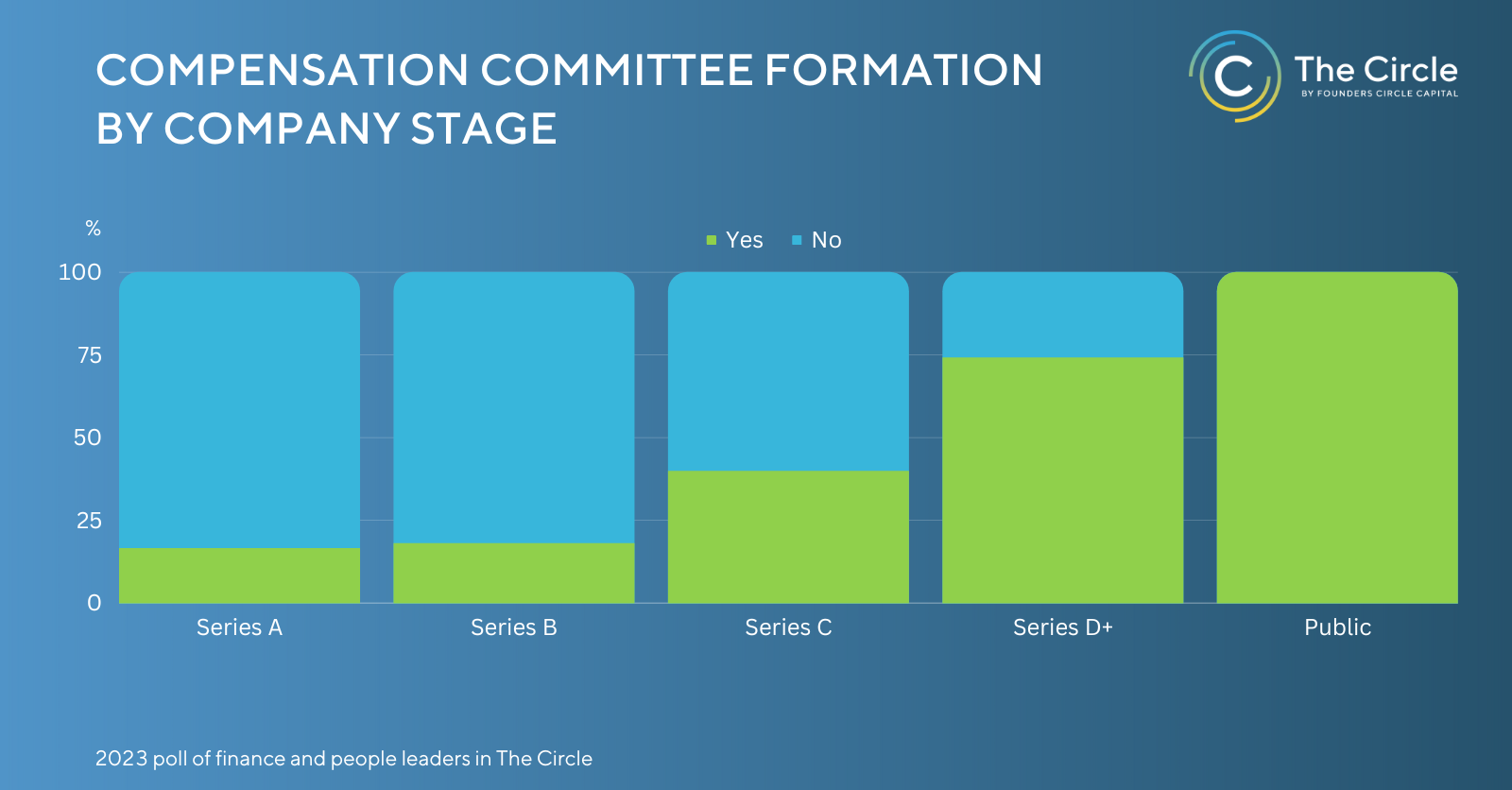Trending
Top CFO Tactics for Reducing Software Spend & Consolidating Systems
/in I'm Looking for Strategic Planning Tips, Software Stack for Growth Companies, Systems & Processes, Trending, Featured on Home/by Matt McCue4 Considerations To Craft Your Company’s Equity Strategy
/in I Need to Retain my Top Performers, Secondary Liquidity, Developing Your Team, Talent, Trending, Equity & Compensation, Featured on Home/by Matt McCueAdvancing Your Influence: Strategies for CFOs
/in CFO Leadership, Leadership & Vision, Developing Your Team, Talent, Trending, Featured on Home/by Matt McCueShare this entry

Compensation Committee Construction
Establishing a charter, selecting board members, and maintaining strategic alignment
Forming a compensation committee isn’t just a prerequisite for transitioning your board of directors from private to public anymore; it can also help shape your organization’s compensation philosophy and strategy. To navigate the complexities of compensation and its growing impact on talent management, growth stage companies are forming compensation committees earlier in their “scale to IPO journey.” A poll of executives in The Circle revealed that 75% of Series D or later companies have a compensation committee.

Compensation committees can oversee a broad mix of human capital-focused issues, from executive compensation to equity incentives and governance around pay-for-performance, pay transparency and pay equity. Therefore, constructing a compensation committee with the right charter, mix of board members, and level of influence with the CEO and broader board of directors is critical for aligning with the evolving needs of the business.
Recently, we convened 50+ finance and people leaders in The Circle to share best practices on compensation committee formation and operations in a conversation with Bindu Culas, Managing Director at FW Cook; Michael Abromowitz, Consultant at FW Cook; and Christy Lake, Chief People Officer at Twilio and member of Petco’s Compensation Committee.
Aligning the Charter With Company Growth
Compensation committees need a charter, not only to formally outline the committee’s duties and responsibilities, but also to establish a mutual understanding of the respective roles and expectations of management and the committee.
In the early stages of company growth, compensation committees tend to focus on executive compensation. As companies get closer to becoming public, the focus broadens to benchmarking pay against a carefully tailored public company peer set, assessing the ongoing retentive value of unvested equity awards held by the management team, and identifying potentially problematic contractual provisions that may be embedded in compensation arrangements (for example, would an IPO or liquidity event inadvertently trigger “change in control” outcomes).
Compensation committees often expand their charter, due to a number of internal and external factors:
“As a company matures, it might need more formal oversight and governance around the organization’s pay philosophy, compensation structure and equity design. At the same time, key investors may be concerned about equity burn or dilution, and some may insist on joining the committee as a condition for investment.” – Bindu Culas, Managing Director, FW Cook
Christy noted that Twilio had updated its compensation committee charter three times in three years. “We started by adding greater oversight of risk management and governance to the charter and then expanded to include DEI, ESG, executive talent management, and assessing the organization’s overall health,” she explained. Bindu described this evolution of the public company compensation committee charter as a shift from “shareholder capitalism to stakeholder capitalism” as compensation becomes a tool for driving performance, promoting accountability, and rewarding achievement across the business.
The most significant change to the compensation committee structure occurs in the lead-up to a public market debut. Once public, a compensation committee needs to adapt to stock exchange listing standards and governance requirements, including having at least two independent board members (with limited exceptions).
Assemble a Diverse Mix of Board Members
With the remit and charter of compensation committees expanding in recent years, filling those board seats has become more challenging. “Compensation committee meetings are getting longer and running the spectrum from approving bonuses, to talking about pay equity and broader human capital topics,” said Bindu. “Undoubtedly, it’s a hard committee to be on.”
Your compensation committee is selected from your existing board of directors and, ideally, should have at least three members (including two independent members, if you’re preparing to go public). Like any strong board, you’ll want diversity in experience and points of view in your committee, with the right members typically including:
- Finance Leaders that know the financials of the business and can help guide measurable performance-based compensation plans.
- People Leaders that can offer insight into workplace trends, people-related issues, and equity needs across the business.
- CEOs that can connect the dots between compensation and everything else happening at the company.
- Female + Underrepresented Leaders – that can bring an important layer of employee empathy and perspective to your board.
- Academic Professionals, such as deans of business schools, that can bring intellectual curiosity and out-of-box ideas to compensation design.
One thing to keep an eye out for in selecting compensation committee board members is whether they have a healthy and balanced relationship with the CEO:
“Your committee needs to maintain an independence factor. For that, you need a chairperson that can work with the CEO, but also challenge their point of view if it’s not in the best interest of the company.” – Michael Abromowitz, Consultant at FW Cook
Christy also advised doing diligence on each board member to see what boards they have sat on and what compensation philosophies they are likely to try and influence at your company.
Give the Committee What it Needs to Govern, Not Manage
Compensation committees take their cues from the data and insights shared by the CEO, CFO, CHRO, and other senior leaders of the organization. While the CFO and CHRO generally have distinct roles with the board, they must be aligned before presenting any strategic proposals to the compensation committee.
“There should never be daylight between your CHRO and your CFO regarding any plans put forward to the compensation committee. To do that, you need to be in absolute lockstep on ensuring the financial metrics, what we are pointing the street towards, is in full alignment with your compensation design.” – Christy Lake, Chief People Officer, Twilio
To keep interactions with your compensation committee productive, our experts offered three pieces of advice:
- Don’t Get Too Granular – Use board meetings to get any approvals or strategic direction you need, and avoid getting too in the weeds on day-to-day operations or program mechanics that may not be the best use of the committee’s time and attention.
- Schedule Pre-Meetings – Have a pre-discussion with the committee chair or individual members to help identify and vet board questions in advance and ensure you’re coming in with the answers they need.
- Get Aligned With Your CEO – “You shouldn’t be ideating in the compensation committee meeting,” said Christy. It’s essential to align with your CEO before giving any recommendations or strategic direction to the board.
The Takeaway:
Compensation committees evolve alongside company growth, but forming one earlier in the growth cycle can give you more time to shape how it functions, who is involved, and what level of influence it has within the organization. Establishing a diverse mix of perspectives is critical, as is striking the right balance between transparency and independence.
Apply to join The Circle and gain access to a private leadership community of CXO peers that regularly exchange ideas, insights, and support.
Related Blog Posts

4 Considerations To Craft Your Company’s Equity Strategy

Evolving Your Compensation Plan on the Road to IPO




